
(Goldstrike Hot Springs and Nevada Hot Springs)
Hiking Around Las Vegas, Lake Mead National Recreation Area

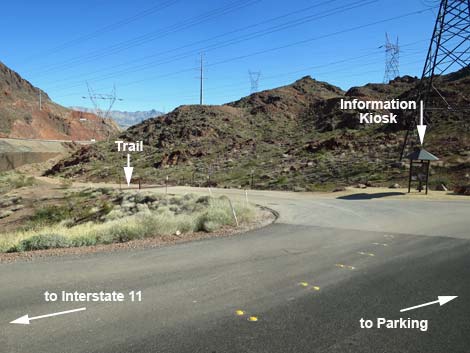 Start of Goldstrike Canyon route (view SE) |
Due to extreme temperatures, this area is closed during summer (usually May 15 to September 30). Link to details (PDF). Overview Goldstrike Canyon is a great hike runs down a narrow, rocky canyon to a series of hot springs and several hot pools that beg for a good soak during cooler weather. Most of the route is a fairly easy, descending some 600 feet in about 2 miles to Goldstrike Hot Springs, but there is some 3rd-class scrambling over and around boulders. There usually are fixed ropes at difficult spots, but ropes come and go, so don't expect an exact number. Ropes also break, so check them on the way down. From Goldstrike Hot Springs, it is 45 minutes and some tough scrambling (more fixed ropes) down to Nevada Hot Springs and the Colorado River. During warm weather, look forward to a quick drip in the icy Colorado. Link to road access map or route map. Download NPS map. |
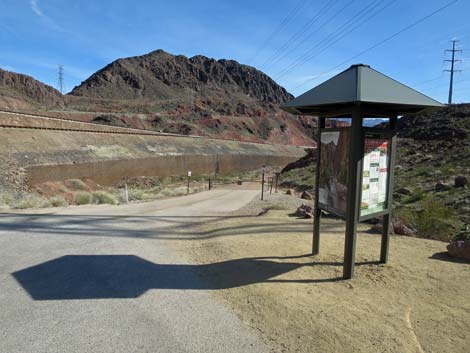 Goldstrike Canyon Trail starts at the information kiosk (view E) |
Because of changing hot-water flows, it is useful to refer to upper Goldstrike Hot Springs (the original main area from the swimming pool upstream) and lower Goldstrike Hot Springs (below the swimming pool and Cave of Wonders). Nevada Hot Springs is farther down near the Colorado River. Earthquakes in about 2004 reduced water flows at upper Goldstrike Hot Springs (historic photos), and flash floods during 2005 filled the upper-most hot tubs with sand and gravel. Water flow has continued to decline, and the main hot springs at upper Goldstrike are now cool or dry. For a good soak in hot water, it is now necessary continue to the Cave of Wonders at lower Goldstrike. The water flow is now so low that it is easy to downclimb the waterfall and bypass the big rock face. The best hot water is now down at Nevada Hot Springs, which is located down near the Colorado River. Hiking to Nevada Hot Springs requires climbing fixed ropes and good scrambling skills. I've seen people fall in the rocks in the lower canyon. Water temperatures in the pools range from about 85-105°F, and water emerging from the rocks is as high as 122°F, so it is worth the effort. |
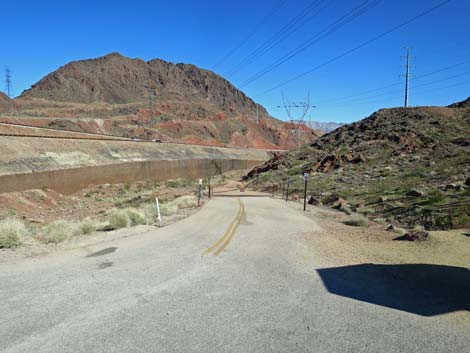 Goldstrike Canyon Trail starts down the closed road (view E) |
Watch Out Other than the standard warnings about hiking in the desert, ...it is a fairly safe hike to Goldstrike Hot Springs, but there are some things to watch out for. The canyon is narrow and subject to flash floods, so skip this hike if you even think it might rain. There are several places where the canyon is choked with house-sized boulders that you have to climb around. People have cut footsteps and left fixed ropes in some places, but it still qualifies as 3rd-class scrambling. If a route over the boulders looks too dangerous, look for a route along the side of the canyon that you might have missed, but judge the safety of your route for yourself. Because of extreme summer temperatures, many hikers have required rescue in this area during recent years, putting the lives of rescue personnel at risk. Therefore, the National Park Service closes Goldstrike Canyon during summer. Hiking to Nevada Hot Springs is a more serious adventure and some people might want a safety rope. A teenager drowned in the Colorado during 2010, so be careful in the river too. |
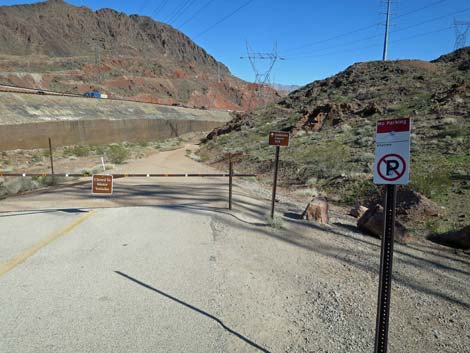 No parking in this area |
Getting to the hot springs is easy -- just walk downhill until you find hot water. However, about 1.5 miles out, three canyons converge in a broad open area. When you get to this point, pay attention to where you came from so you will remember how to get out. Even with footprints in the gravel, the wash you came down isn't the obvious choice on the way out. Warnings about Naegleria fowleri and the dangers of getting a deadly Naegleria fowleri infection while swimming in hot springs are offered by people at the hot springs, signs at some Lake Mead hot springs (but not in Goldstrike Canyon), and notices on the Internet. It seems to me that the chance of contacting Naegleria fowleri is extremely low, but judge for yourself. Many people soak here, and none have died so far as I know, so I just enjoy the hot water, keep my nose out of the water, and don't worry about it. Water levels at the river can fluctuate rapidly as more or less water is released from the dam, so be careful about getting stranded if you try to venture from the canyon mouth (e.g., try to visit Sauna Cave). |
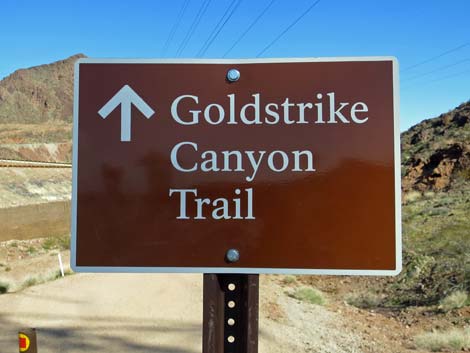 Goldstrike Canyon Trail sign (view E) |
Other thoughts. This is not a good trail for dogs. If you take a dog, be ready to do the rock climbing while carrying your dog. Some people with a black lab didn't seem to be having fun, although the people with the rat-sized thing just stuffed it in a backpack and did fine going over the rocks. Don't leave dog poop in the canyon. There are no toilet facilities in the canyon, and there are few private places at the hot springs, so consider doing your business before you get there. This is another good reason to leave the pets at home. Don't take any glass containers -- too much rock and too many bare feet. Don't get hurt down there; it would be a difficult place for a rescue. While hiking, please respect the land and the other people out there, and try to Leave No Trace of your passage. Also, this is a fairly long hike, so be sure to bring the 10 Essentials. |
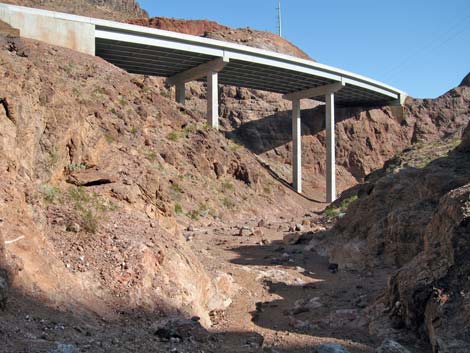 Approaching the highway bridge (view NE) |
Getting to the Trailhead This hike is located off Interstate 11 near Hoover Dam in Lake Mead National Recreation Area, about 45 minutes southeast of downtown Las Vegas. Drive south on Interstate 11 to Nevada Exit #2. Stay right to Goldstrike Canyon Trailhead. The Hike From the parking lot, the trail exits the parking lot back towards the Interstate, but then turns right onto the old access road, which is now gated. Watch for an information kiosk (Table 1, Waypoint 00) at the start of the old access road and a sign by the gate: Goldstrike Canyon Trail. The route runs down the old access road about 0.3 miles to the original trailhead (Wpt. 01), then continues down the canyon, which feels deep, but fairly open at first. At the next bend in the canyon, the route runs under one of the Interstate-11 spans. Keep an eye out for cars and trucks that crashed off the old road and into the canyon. They say that some of the debris here is local color left over from when they built the dam. |
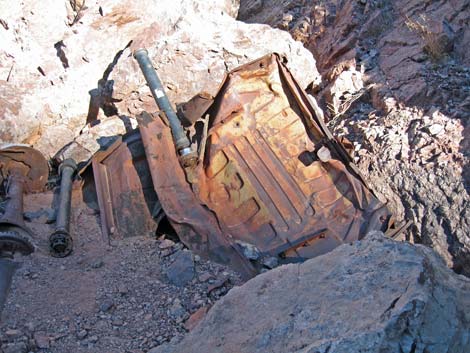 An historic addition to the wilderness experience |
Soon the canyon walls get steeper and the wash narrows. Watch for desert bighorn sheep browsing on the steep hillsides above the wash. There is plenty for them to eat along the canyon. This area is in the Upper Sonoran (Mojave Desert Scrub) life zone, and the vegetation along the wash is fairly lush for this area. The most common plant species along the wash are Catclaw Acacia, Brittlebush, Creosote Bush, White Bursage, and Burrobrush (Cheeseweed). In wet places, keep an eye out for Maidenhair Ferns and Narrow-leaved Cattail, species that you wouldn't expect in the desert. Eventually, the canyon walls become vertical. Be sure to notice the geology along the route. The rock is volcanic, and there are some fascinating rock structures in the canyon. You can, for example, find places where hot springs once flowed and places where boulders and gravel seem to be glued to the side of the cliffs above your head. While clambering around, be sure to stay out of the Desert Stingbush (aka Rock Nettle) growing on the rocky walls. |
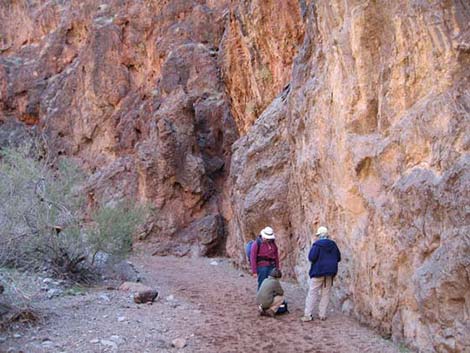 Deep, narrow canyon (view E) |
At about 1.6 miles out, the canyon is narrow, and an enormous boulder blocks the wash. Standing atop the boulder, it looks about 25 feet down to the wash below. Bypass the boulder by carefully stepping down the stairs cut in the rock wall on the right (south) side. Unfortunately, the first two steps are the smallest; the rest are larger and more reassuring. From above, this looks far worse than it really is; coming up, you just walk up the steps without hesitating. Below the boulder, the deep and narrow canyon suddenly opens into a broad, open area (Wpt. 02) vegetated with lots of creosote bush. Pay attention at this spot because it is easy to get confused here on the way out. Turn around and look back at the slot canyon you just came through; make a mental image so you will recognize the place when hiking out. An alternate route back to old Highway 93 (not the trailhead) used to go north here, but the route is blocked by the Interstate highway. The route that appears most obvious is the canyon to the south, but this is not the best way back to the trailhead. Remember your route on the way down so you can find your way out. |
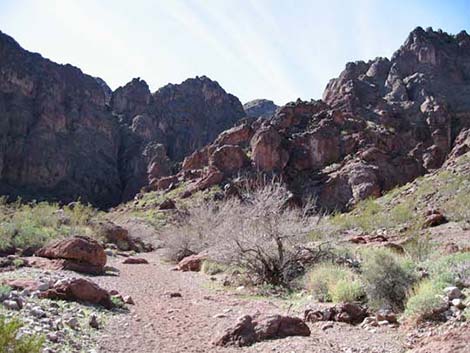 The upper canyon is open (view E) |
The route continues down the wash through the open area. Soon the canyon narrows again, the walls get steeper, and there are several pour-overs to negotiate and boulders to scramble around, under, and over. Nearing upper Goldstrike Hot Springs, the route bypasses a huge boulder with a fixed rope to assist on the lower parts. This area once was a Saltcedar jungle, but it was cleared by fire and repeated efforts of saltcedar removal crews. Saltcedar is an invasive plant that the National Park Service is trying to remove because it crowds out native species and provides little benefit to wildlife. About 0.5 miles below the open area, the route climbs over a boulder, and suddenly hikers arrive at the built-up hot tubs that are Upper Goldstrike Hot Springs (Wpt. 03). Upper Goldstrike Hot Springs is located in a deep, narrow section of canyon that is choked with boulders. People built retaining walls under a few of the boulders to create hot tubs, and at the bottom of this section, a 6-foot-high dam formerly held back a backyard-sized swimming pool full of hot water. Very inviting. |
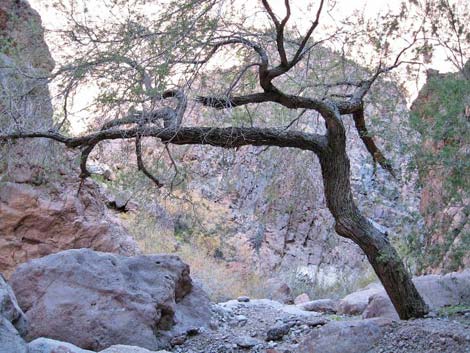 Big, old Catclaw Acacia tree in the canyon bottom (view E) |
As of January 2010, the water in the two remaining pools was low and not particularly hot, and the old swimming pool was completely dry. While some of this reduction might be due to the drought, it appears that the hot water flows in this area are continuing to decline. Therefore, to get to good hot pools with real hot water, continue past the old swimming pool. With the water flows so low, continuing down the canyon a few hundred yards is easy and leads to nice pools. Blue-green algae grows in the very hottest water, so if you see algae, be careful before you get in the water. Just below the old swimming pool dam, the canyon jogs to the south, runs straight for about 100 yards, then jogs to the east again. Just after turning the corner, an enormous, water-polished boulder blocks the canyon. A fixed rope helps here, but the last step is a doosey (especially on the way back up). Be sure you can get back up before jumping off the end. If the rope is missing, consider not sliding down the boulder. With the low water flows, it is possible to downclimb the waterfall next to the boulder without getting wet. |
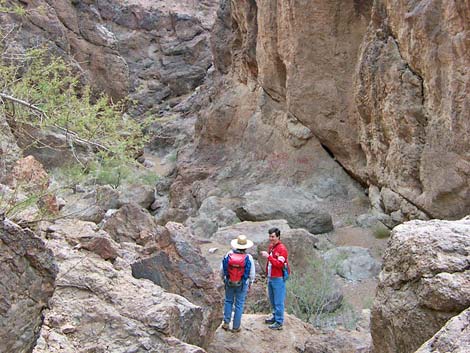 Pass pour-over to the left (view E) |
For most people, this area (lower Goldstrike Hot Springs, aka Cave of Wonders) is the place to stop. The pools are small but warm and inviting, the company can be good, and the canyon is spectacular. For others, the hike to Nevada Hot Springs and the Colorado River takes another 30-45 minutes. Lower down, parts of the route run along the side of the canyon where people trimmed back the Catclaw Acacia and Saltcedar bushes. Other places, the route just climbs down boulders and around waterfalls, including some 3rd-class scrambling, and there are 3 more places with fixed ropes (total of 4 fixed ropes below Upper Goldstrike Hot Springs). Near the bottom of the canyon, a few hundred yards from the river, the stream flows into Nevada Hot Springs (Wpt. 04) with some very nice hot tubs and even a hot waterfall coming off the side of the canyon that provides a nice shower. |
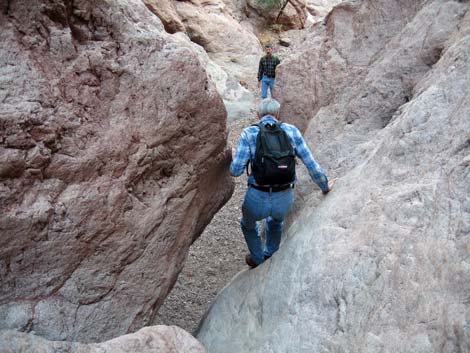 First obstacle: from above, it looks far worse than it is (view E) |
Continuing downstream, the route pops out of the narrow canyon onto a small gravel beach at the edge of the Colorado River (Wpt. 05). There is a nice rock outcrop at the mouth of the canyon where one can sit, relax, eat lunch, and contemplate the passing of old-man river. The water level in the river can change by several feet depending on how much water is released from the dam, so sometimes you can walk out onto the rock outcrop, and other times you need to wade out. Similarly, trying to visit Sauna Cave (upstream a bit) can leave you stranded if the water comes up quickly. After relaxing by the cold water at the river (or the hot water in the springs) and eating lunch, retrace your steps to the trailhead (Wpt. 00). |
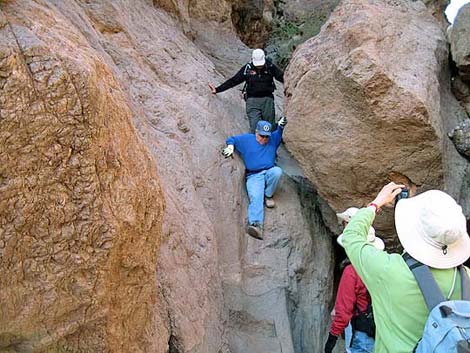 First obstacle: footsteps cut in the rock help (view W) |
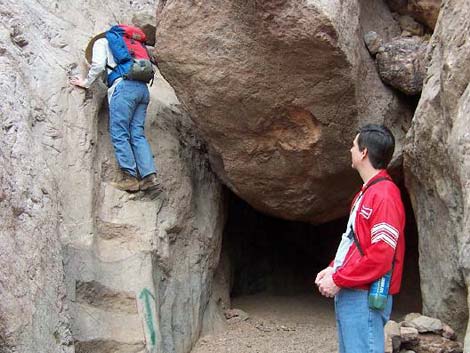 First obstacle: footsteps cut in the rock help (view W) |
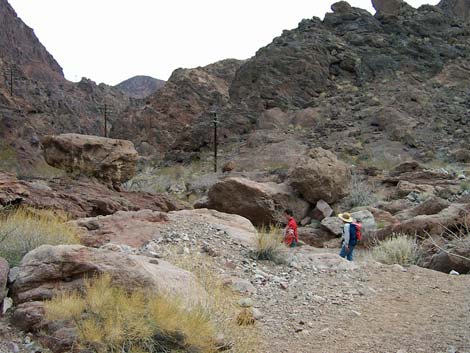 Open area after narrows -- look back to recognize the correct canyon |
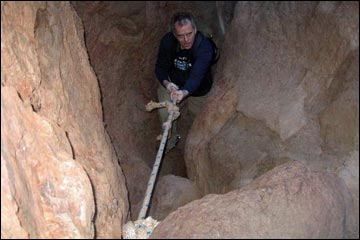 Hiker using fixed rope to descend a slot (view E) |
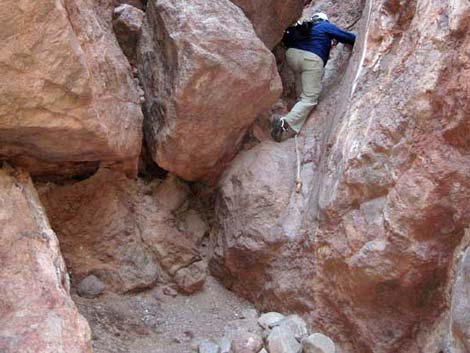 First fixed rope (view from below) |
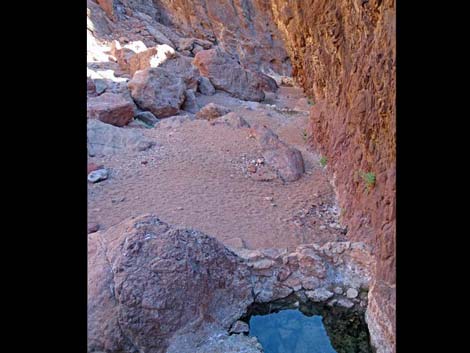 Main area in 2010; hot pools are low or dry |
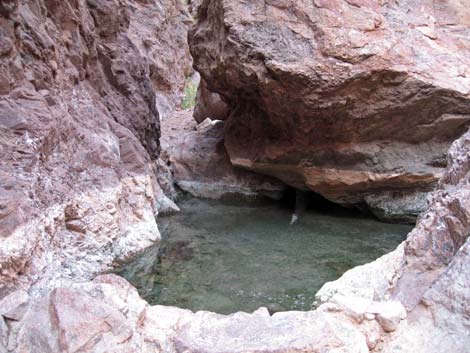 2010; my favorite pool is almost dry |
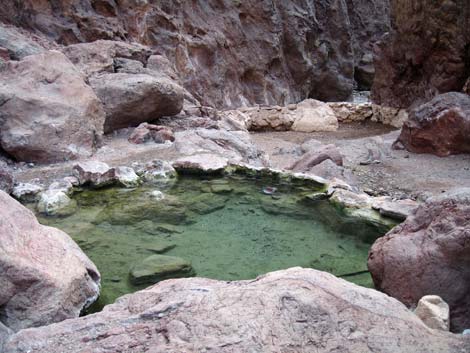 2010; last deep pool in the upper area |
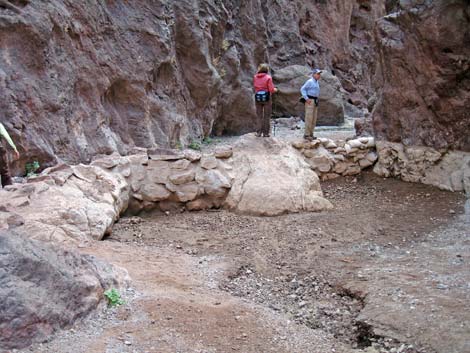 2010; big pool in upper hot springs area is dry |
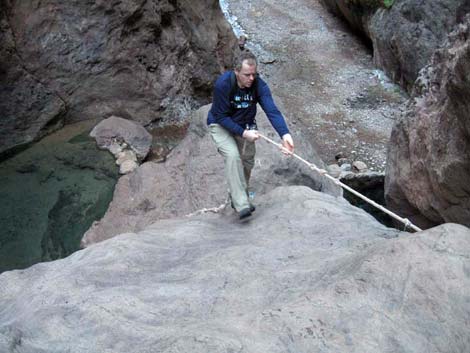 Hiker on slick rock. The rope runs out before the slick rock does |
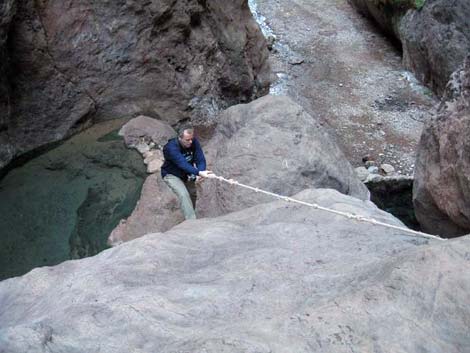 Second fixed rope. Hiker making the last big step down |
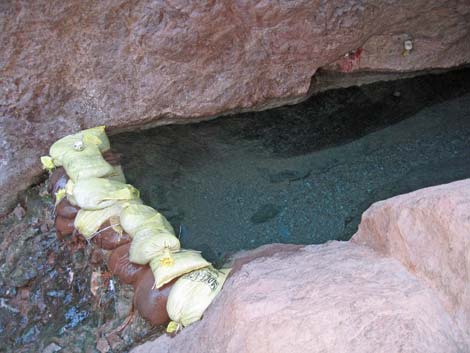 Cave of Wonders pool |
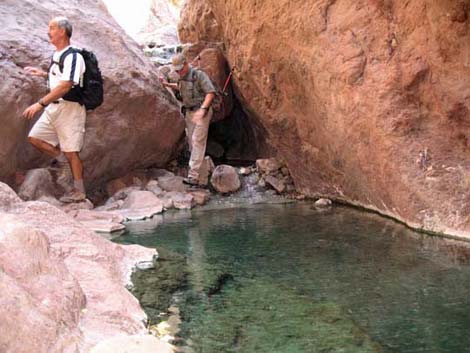 Hikers bypassing the second fixed rope by downclimbing the waterfall |
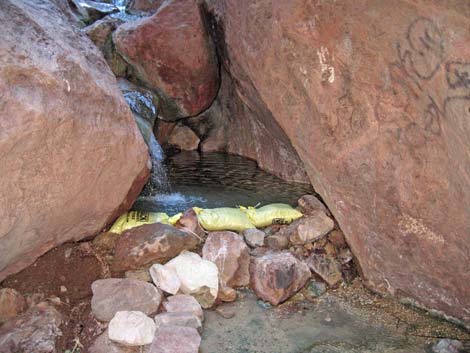 With just a trickle, it is now easy to downclimb the waterfall |
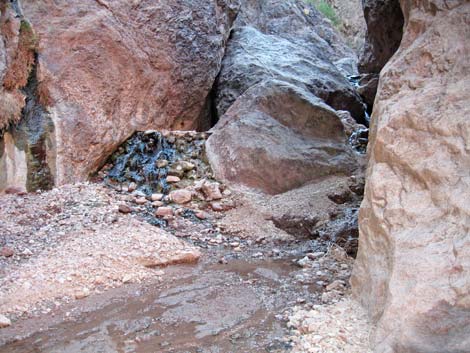 Lower Hot Springs, aka Cave of Wonders - small and hot; 2010 |
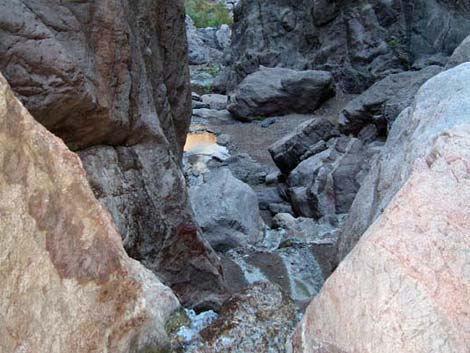 Continuing down the canyon |
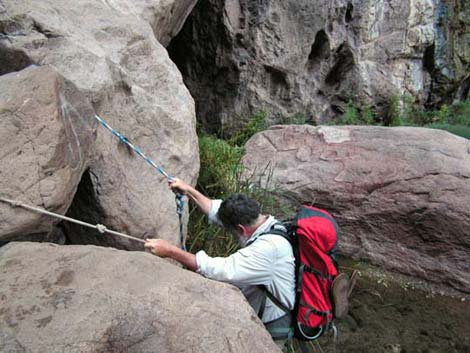 Third fixed rope (view from above) |
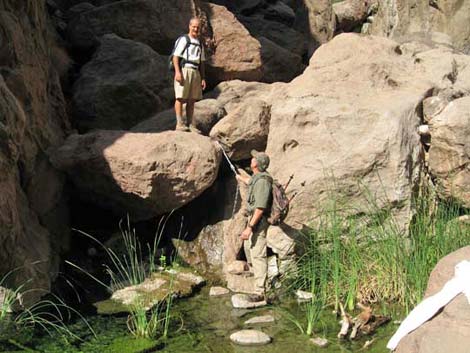 Third fixed rope (view from below) |
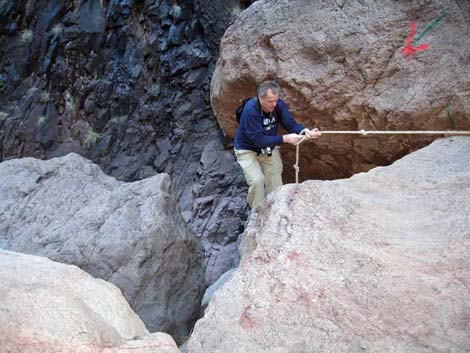 Fourth fixed rope (view from above) |
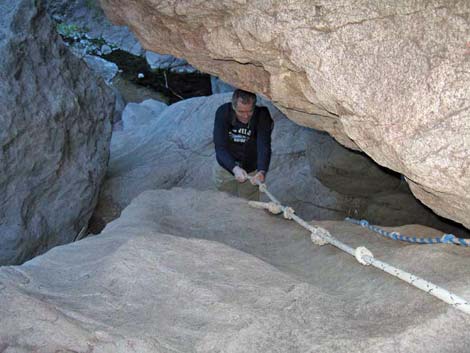 Fourth fixed rope (view from above); this is quite awkward |
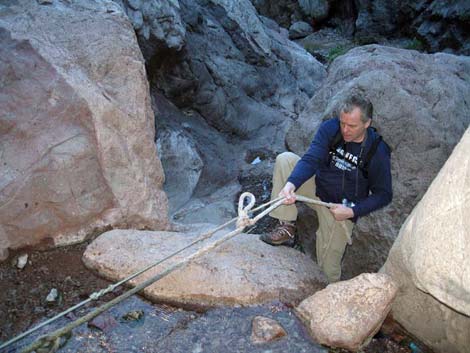 Fifth fixed rope (view from above) |
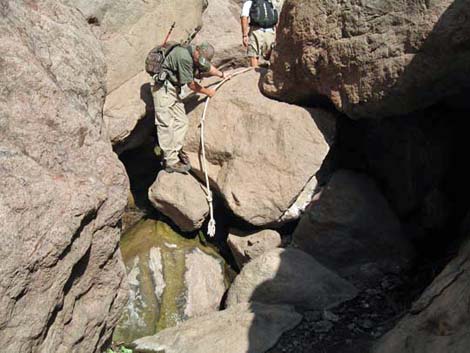 Fifth fixed rope (view from below). Another awkward move |
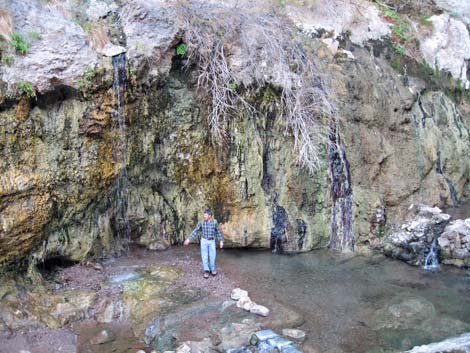 Nevada Hot Springs; one of several hot pools |
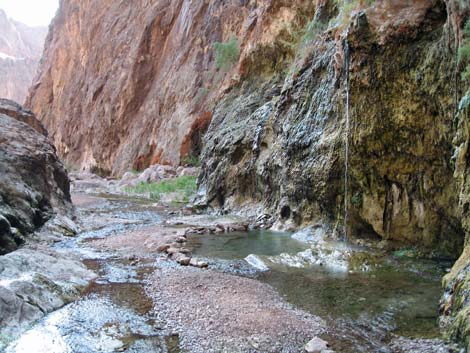 Nevada Hot Springs with hot shower (view E) |
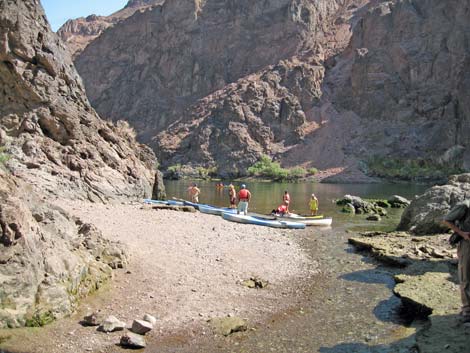 Goldstrike Beach on the Colorado River |
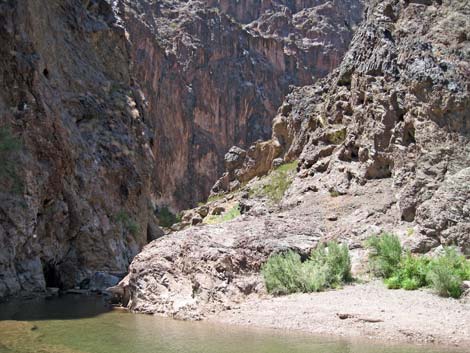 Goldstrike Canyon (view west from Colorado River). |
Table 1. Hiking Coordinates Based on GPS Data (NAD27; UTM Zone 11S). Download Hiking GPS Waypoints (*.gpx) file.
| Wpt. | Location | UTM Easting | UTM Northing | Elevation (ft) | Point-to-Point Distance (mi) | Cumulative Distance (mi) |
|---|---|---|---|---|---|---|
| 00 | Information Kiosk | 700708 | 3987167 | 1,660 | 0.00 | 0.00 |
| 01 | End of Closed Road | 701160 | 3987154 | 1,580 | 0.31 | 0.31 |
| 02 | Broad, Open Area | 702443 | 3986229 | 1,120 | 1.38 | 1.69 |
| 03 | Goldstrike Hot Springs | 702926 | 3986427 | 960 | 0.38 | 2.07 |
| 04 | Nevada Hot Springs | 703424 | 3986101 | 775 | 0.45 | 2.52 |
| 05 | Goldstrike Canyon at Colorado River | 703567 | 3986110 | 701 | 0.09 | 2.61 |
| 00 | Information Kiosk | 700708 | 3987167 | 1,660 | 2.61 | 5.22 |
Happy Hiking! All distances, elevations, and other facts are approximate.
![]() ; Last updated 240326
; Last updated 240326
| Hiking Around Lake Mead | Hiking Around Las Vegas | Glossary | Copyright, Conditions, Disclaimer | Home |